SOD Sciences Inc.: Cracking the Genetic-Environmental Code Behind Depression

Depression rates in the United States have climbed relentlessly over the past three decades. While greater awareness and improved diagnostics account for part of the rise, the scale and demographic patterns remain striking. Rates have surged most dramatically among Asian and Black Americans since the 1990s, while increases in White populations have been far more modest.
The conventional explanations, sociocultural stress, better reporting, changing lifestyles, cannot fully explain why certain populations are disproportionately affected. Something deeper is at work.
SOD Sciences Inc. proposes a unifying explanation: genetic vulnerability colliding with modern environmental triggers. This “perfect storm” of oxidative stress is not only driving depression but also feeding into the wider spectrum of chronic diseases. And SOD Sciences is not merely pointing out the problem. The company has patented a solution, built entirely on GRAS-certified components validated in double-blind studies, designed to restore the body’s natural antioxidant defenses and break the cycle of disease.
Genetic Vulnerability: The Weak Links in Redox Defense
The foundation of this theory rests on two key genetic polymorphisms: SOD2 rs4880 and GPX1 rs1050450.
SOD2 encodes manganese superoxide dismutase, the primary antioxidant enzyme that protects mitochondria. Individuals who inherit the TT genotype at rs4880 experience impaired mitochondrial import and 30–40% reduced enzyme activity. This leaves them chronically under-defended against oxidative stress from birth. The TT genotype is found in nearly 80% of East Asians, about 55% of Black Americans, and only 20–25% of Europeans.
GPX1 encodes glutathione peroxidase, another frontline antioxidant enzyme. The T allele at rs1050450 is associated with impaired peroxide detoxification and greater oxidative burden. Carriers of both SOD2 TT and GPX1 TT genotypes are particularly vulnerable.
This genetic map aligns almost perfectly with population-level depression statistics. Groups with the highest prevalence of SOD2 and GPX1 insufficiency are the ones experiencing the steepest rises in depression.
Environmental Triggers: Modern Catalysts of Oxidative Stress
The turn of the millennium marked an explosion in artificial sweetener consumption. Diet sodas, processed foods, and energy drinks introduced massive new exposures to aspartame and related compounds. Multiple studies now link these additives to higher rates of depression, and the risk is particularly pronounced in those with oxidative stress vulnerabilities.
As Asian and Black populations adopted more Westernized diets heavy in artificial sweeteners, depression rates skyrocketed. The timing and scale are too precise to be coincidence.
Pet Ownership and Toxoplasma Exposure
Cats bring companionship, but they also carry Toxoplasma gondii, a parasite strongly associated with mood disorders. Toxoplasma induces oxidative stress cascades, downregulates critical brain enzymes, and disrupts neurotransmitter systems. In individuals with compromised SOD2 activity, the parasite can tip the balance into full glutathione collapse and depressive illness.
Historically, Asian and Black households had lower cat ownership, which provided a measure of protection. As pet ownership has increased in these groups, depression rates have risen in parallel. Whites, despite high pet ownership, have largely been shielded by their lower SOD2 TT prevalence.
Pharmaceuticals as Hidden Burdens
Commonly prescribed medications also add to the oxidative load. SSRIs, the very drugs used to treat depression, can deplete glutathione and increase oxidative stress with long-term use. Steroids (glucocorticoids) cause hippocampal oxidative damage and epigenetic changes, raising neurodevelopmental risks in infants. Antibiotics strip away short-chain fatty acid–producing gut bacteria, dismantling one of the body’s critical antioxidant defenses.
For genetically vulnerable individuals, these pharmaceutical exposures are not neutral, they compound the oxidative burden and accelerate glutathione depletion.
Molecular Pathways: From Oxidative Stress to Depression
At the molecular level, depression emerges not as a vague imbalance of “chemicals” but as a precise biochemical cascade.
- TKTL1 dysfunction impairs the pentose phosphate pathway, starving the cell of NADPH required to recycle glutathione.
- ST3GAL1 dysregulation disrupts glycosylation pathways, destabilizing synaptic proteins necessary for mood regulation.
- Glutathione depletion removes the master antioxidant shield, allowing mitochondrial dysfunction, neuroinflammation, and excitotoxicity to take hold.
These failures are not random. They are predictable outcomes when genetic vulnerabilities meet environmental triggers.
The Unified Disease Theory
Viewed in isolation, depression, Alzheimer’s disease, diabetes, cardiovascular disease, and autoimmune conditions seem distinct. Yet under the surface, they share the same engine: chronic oxidative and nitrosative stress.
SOD2 insufficiency sets the stage. Environmental exposures, artificial sweeteners, pet-borne parasites, pharmaceuticals, pull the trigger. And glutathione depletion seals the fate, leaving tissues defenseless.
In this light, chronic diseases are not separate battles but different battlefields in the same war. The implication is profound: by restoring glutathione through natural pathways, we can slow, halt, or even prevent the cascade of disease altogether.
The SOD Sciences Solution
SOD Sciences has developed and patented a substrate formulation designed to revive endogenous glutathione reserves. The formula combines tagatose, Fibersol-2, and pectin, with optional leucovorin.
Each component is GRAS, each validated in numerous double-blind studies. Together, they create a synergistic, multi-modal therapy:
- Tagatose improves glucose metabolism, disrupts pathogenic parasite and bacterial energy use, and protects TKTL1 from oxidative disruption.
- Fibersol-2 generates short-chain fatty acids in a slow, tolerable way, fueling glutathione regeneration and dampening inflammation.
- Pectin reinforces gut barrier integrity, supports beneficial bacteria, and lowers systemic oxidative stress.
- Leucovorin, when added, enhances folate metabolism, supports glutathione synthesis, and even provides direct anti-parasitic effects against Toxoplasma.
Evidence shows that this substrate does more than supply antioxidants from the outside—it stimulates the body’s own natural machinery to restore reduced glutathione, the master defense system.
Clinical and Market Strategy
To validate and expand adoption, SOD Sciences has entered agreements with major health institutions. These partnerships enable deployment of oxidative stress panels to stratify patients, guide treatment, and collect longitudinal data. Each patient treated becomes a datapoint that sharpens protocols and strengthens the evidence base.
Because all components are GRAS, the company avoids the decade-long regulatory gauntlet of drug approval. The formulation can be compounded today and scaled tomorrow. Initial market entry will focus on longevity clinics, corporate wellness programs, and early-adopter consumers, with broader healthcare integration as evidence mounts.
Implications for Healthcare and Society
The implications reach far beyond depression. By targeting the oxidative root cause, SOD Sciences’ solution reduces the need for downstream interventions, lowers lifetime medical costs, and directly addresses health disparities. Populations most burdened by genetic vulnerability stand to benefit the most.
This is a scientific, economic and societal shift. Prevention is cheaper than treatment, and longer health span means healthier lives, stronger productivity, and reduced systemic strain.
A Healthcare Revolution in Motion
The modern epidemic of depression is not a mystery. It is the predictable outcome of genetic insufficiency colliding with modern exposures. The SOD2 TT genotype, common in Asians and Blacks, leaves millions vulnerable to oxidative overload from artificial sweeteners, pharmaceuticals, and parasites like Toxoplasma. The result is a surge in depression and related chronic diseases.
SOD Sciences has developed a patented solution that restores glutathione through the body’s own natural pathways. Built on GRAS-certified, clinically validated components, and deployed in partnership with major institutions, the platform offers a path forward.
This is more than an incremental improvement. It is a paradigm shift: one disease at the root, one solution at the source. By treating the oxidative engine rather than the dashboard lights, SOD Sciences is poised to redefine healthcare for the next century—delivering not only longer lives, but longer, healthier lives.





